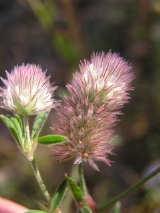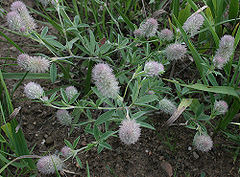
Hare's-foot clover
Encyclopedia
Trifolium arvense is a species of clover
. It may also be known as Haresfoot clover, Rabbitfoot clover, Stone clover, Hare's-foot clover is a common name for the plant or Oldfield clover. This species of clover is native to most of Europe
, excluding the arctic zone, and western Asia
, in plain or mid-mountain habitats up to 1600 m altitude. It grows in dry sandy soil
s, both acid
ic and alkaline, typically found at the edge of fields, in wastelands, at the side of roads, on sand dunes, and opportunistically in vineyards and orchards when they are not irrigated.
 It is a small erect herbaceous
It is a small erect herbaceous
annual
, or sometimes biennial
plant, growing to 10-40 cm tall. Like all clovers, it has leaves
divided into three sessile leaflet
s, which are slender, 1-2 cm long and 3-5 mm broad, and sometimes edged with small hairs and finely serrated. The leaves have a pair of stipule
s at the base, often tipped in red. The flower
s are grouped in a dense inflorescence
2-3 cm long and 1-1.5 cm broad; each flower is 4-5 mm long, rosy white in colour, and especially characterised by the many silky white hairs which tip the five sepals, which are much larger than the petals. These hairs, along with the more or less oblong form of the inflorescence, are the inspiration for the common name. Pollination
is carried out by bees, or via autogamy, since the plant is hermaphroditic
, and the flowering season is from mid-spring to late summer. The fruit
is a small pod containing a single seed
.
, making it valued on low fertility soils for the benefit it gives to other crop species in supplying nitrogen
. It is also grazed by sheep and goat
s.
It has been introduced to North America
, where it is an invasive species
in some areas.
Scientist at AgResearch in New Zealand have used genetic modification to take a single gene from Trifolium arvense and put it into the more common white clover. The genetically modified clover would reduce bloating in livestock and decrease methane emissions. The release of the genetically modified clover is expected to be 15 years off.
Clover
Clover , or trefoil, is a genus of about 300 species of plants in the leguminous pea family Fabaceae. The genus has a cosmopolitan distribution; the highest diversity is found in the temperate Northern Hemisphere, but many species also occur in South America and Africa, including at high altitudes...
. It may also be known as Haresfoot clover, Rabbitfoot clover, Stone clover, Hare's-foot clover is a common name for the plant or Oldfield clover. This species of clover is native to most of Europe
Europe
Europe is, by convention, one of the world's seven continents. Comprising the westernmost peninsula of Eurasia, Europe is generally 'divided' from Asia to its east by the watershed divides of the Ural and Caucasus Mountains, the Ural River, the Caspian and Black Seas, and the waterways connecting...
, excluding the arctic zone, and western Asia
Asia
Asia is the world's largest and most populous continent, located primarily in the eastern and northern hemispheres. It covers 8.7% of the Earth's total surface area and with approximately 3.879 billion people, it hosts 60% of the world's current human population...
, in plain or mid-mountain habitats up to 1600 m altitude. It grows in dry sandy soil
Soil
Soil is a natural body consisting of layers of mineral constituents of variable thicknesses, which differ from the parent materials in their morphological, physical, chemical, and mineralogical characteristics...
s, both acid
Acid
An acid is a substance which reacts with a base. Commonly, acids can be identified as tasting sour, reacting with metals such as calcium, and bases like sodium carbonate. Aqueous acids have a pH of less than 7, where an acid of lower pH is typically stronger, and turn blue litmus paper red...
ic and alkaline, typically found at the edge of fields, in wastelands, at the side of roads, on sand dunes, and opportunistically in vineyards and orchards when they are not irrigated.

Herbaceous
A herbaceous plant is a plant that has leaves and stems that die down at the end of the growing season to the soil level. They have no persistent woody stem above ground...
annual
Annual plant
An annual plant is a plant that usually germinates, flowers, and dies in a year or season. True annuals will only live longer than a year if they are prevented from setting seed...
, or sometimes biennial
Biennial plant
A biennial plant is a flowering plant that takes two years to complete its biological lifecycle. In the first year the plant grows leaves, stems, and roots , then it enters a period of dormancy over the colder months. Usually the stem remains very short and the leaves are low to the ground, forming...
plant, growing to 10-40 cm tall. Like all clovers, it has leaves
Leaf
A leaf is an organ of a vascular plant, as defined in botanical terms, and in particular in plant morphology. Foliage is a mass noun that refers to leaves as a feature of plants....
divided into three sessile leaflet
Leaflet
A leaflet in botany is a part of a compound leaf. A leaflet may resemble an entire leaf, but it is not borne on a stem as a leaf is, but rather on a vein of the whole leaf. Compound leaves are common in many plant families...
s, which are slender, 1-2 cm long and 3-5 mm broad, and sometimes edged with small hairs and finely serrated. The leaves have a pair of stipule
Stipule
In botany, stipule is a term coined by Linnaeus which refers to outgrowths borne on either side of the base of a leafstalk...
s at the base, often tipped in red. The flower
Flower
A flower, sometimes known as a bloom or blossom, is the reproductive structure found in flowering plants . The biological function of a flower is to effect reproduction, usually by providing a mechanism for the union of sperm with eggs...
s are grouped in a dense inflorescence
Inflorescence
An inflorescence is a group or cluster of flowers arranged on a stem that is composed of a main branch or a complicated arrangement of branches. Strictly, it is the part of the shoot of seed plants where flowers are formed and which is accordingly modified...
2-3 cm long and 1-1.5 cm broad; each flower is 4-5 mm long, rosy white in colour, and especially characterised by the many silky white hairs which tip the five sepals, which are much larger than the petals. These hairs, along with the more or less oblong form of the inflorescence, are the inspiration for the common name. Pollination
Pollination
Pollination is the process by which pollen is transferred in plants, thereby enabling fertilisation and sexual reproduction. Pollen grains transport the male gametes to where the female gamete are contained within the carpel; in gymnosperms the pollen is directly applied to the ovule itself...
is carried out by bees, or via autogamy, since the plant is hermaphroditic
Hermaphrodite
In biology, a hermaphrodite is an organism that has reproductive organs normally associated with both male and female sexes.Many taxonomic groups of animals do not have separate sexes. In these groups, hermaphroditism is a normal condition, enabling a form of sexual reproduction in which both...
, and the flowering season is from mid-spring to late summer. The fruit
Fruit
In broad terms, a fruit is a structure of a plant that contains its seeds.The term has different meanings dependent on context. In non-technical usage, such as food preparation, fruit normally means the fleshy seed-associated structures of certain plants that are sweet and edible in the raw state,...
is a small pod containing a single seed
Seed
A seed is a small embryonic plant enclosed in a covering called the seed coat, usually with some stored food. It is the product of the ripened ovule of gymnosperm and angiosperm plants which occurs after fertilization and some growth within the mother plant...
.
Cultivation and uses
Like most legumes, it fixes nitrogenNitrogen fixation
Nitrogen fixation is the natural process, either biological or abiotic, by which nitrogen in the atmosphere is converted into ammonia . This process is essential for life because fixed nitrogen is required to biosynthesize the basic building blocks of life, e.g., nucleotides for DNA and RNA and...
, making it valued on low fertility soils for the benefit it gives to other crop species in supplying nitrogen
Nitrogen
Nitrogen is a chemical element that has the symbol N, atomic number of 7 and atomic mass 14.00674 u. Elemental nitrogen is a colorless, odorless, tasteless, and mostly inert diatomic gas at standard conditions, constituting 78.08% by volume of Earth's atmosphere...
. It is also grazed by sheep and goat
Goat
The domestic goat is a subspecies of goat domesticated from the wild goat of southwest Asia and Eastern Europe. The goat is a member of the Bovidae family and is closely related to the sheep as both are in the goat-antelope subfamily Caprinae. There are over three hundred distinct breeds of...
s.
It has been introduced to North America
North America
North America is a continent wholly within the Northern Hemisphere and almost wholly within the Western Hemisphere. It is also considered a northern subcontinent of the Americas...
, where it is an invasive species
Invasive species
"Invasive species", or invasive exotics, is a nomenclature term and categorization phrase used for flora and fauna, and for specific restoration-preservation processes in native habitats, with several definitions....
in some areas.
Scientist at AgResearch in New Zealand have used genetic modification to take a single gene from Trifolium arvense and put it into the more common white clover. The genetically modified clover would reduce bloating in livestock and decrease methane emissions. The release of the genetically modified clover is expected to be 15 years off.

